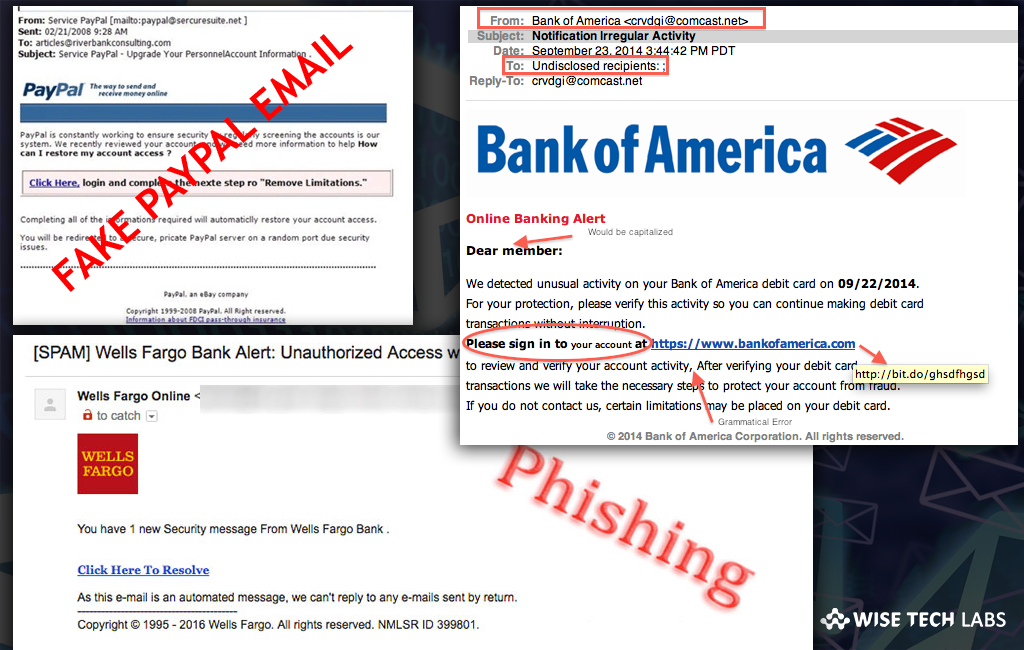6 Quick Ways To Spot Spam Email

6 Quick Ways To Spot Spam Email – This post will help you learn about the best practices to quickly spot any spam email in mailbox.
Every day, we receive lots of mails to our inbox, some may be important ones, some promotional and some may be just spam. Not only that, the emails from unknown sender contains links, attachments and zipped files that may contain compromised codes to spread viruses like ransomware.
It is worth saying that, phishing is one of the most common ways through which people are getting scammed.
Many users fails to follow the best practices for password creation, password saving and account management. According to various surveys it has been identified that users mostly use their personal information like birth-date, nicknames, or numeric combinations just like “12345” as their password. The cyber-criminals can easily crack the passwords which are like these easy formats and take over the online accounts.
Everyone of us is busy in our daily lives, thus we sometimes forget to check the legitimacy of the mails and just seeing their catchy subject lines, we open them or download attachments in such emails or click links from such emails.. Fake and in-genuine mails can be for the following subjects:
- Fake job opportunities asking to pay some money;
- Compromised documents that appear healthy, but contains malicious payloads to drop any serious threat on your System;
- Fraud invoices, fax and shipments that try to mislead people;
- Scams to win some prizes or rewards or surveys that redirect to fake websites asking for private information;
And the list continues…

So, here we are listing 6 Quick Ways To spot Spam Emails through which you can avoid to be a victim of scams.
1. Give a closer look to the subject line of the email: Most of the mails comes with a subject line that shows the motive of the email. For example : “job opportunity,” “Invoice” “Survey,” “Make money fast,” and so on. Such type of emails may contain some virus or scam links that may collect your private information.
2. Be cautious while opening any attached files: Unless you are expecting any email with an attachment with known sender, carefully watch for the attachment before downloading it such as .exe file or .vbs file extension. Such type of extension may contain malicious payloads for malware, spyware, viruses and even ransomware. If the attachment file is any MS office files, then it may ask you to enable macros to run the script. But do not do so, unless the source is verified.
3. Verify the sender before responding or providing any information: If the sender of the mail is unfamiliar to you, then it may be a spam or contain harmful link. Don’t be in a hurry to respond to such emails. If the mail does not concern you, then better move them to spam folder.
4. Go Through The Message Body carefully. Cyber-criminals shoots-out spam emails in bulk, pretending to be some important company or organization. The mail may seem important but actually can be sent by any hacker or an attacker. This is known as forging or spoofing email. Sometimes even email can be from your friend from social media or family in contact, that contains a link to watch any video, download applications or simply says to download a particular document. It can be the case that, the sender is already been infected and its contact is being used to spread spam. This can be a sign of spam email. In such case, do not open such attachment and immediately inform the sender about the same that his account may be compromised.
5. Check For Grammatical errors or Spelling mistakes: Spam emails may not have a relevant subject line and also the message body does not have any useful or complete information. They just ask user download the attachment or visit the link for more information. Sometimes, the message body have some text with spelling and grammatical mistakes like punctuation marks and so. Such emails can indicate a spam one.
6. Do not click on links unless verified: Sometimes the emails are sent from YouTube, gaming sites or some unknown websites. They appear as promotional emails, but hackers may have some compromised links embedded within such emails. When clicked by the user, it may redirect you to hacked websites. The payloads of such virus can silently download within the background. So, before clicking on the link you should verify if the link is safe to click or not.
Apart from all these, you should avoid email that claims for big rewards, download free software programs and surveys. Nothing comes for FREE. A little cautiousness can avoid a great damage and secure your online privacy. Also spread these words of caution to your friends and family. This will surely help you to stay alert against spam emails.
Always be willing to educate fellow users, friends and family members if you have spotted some spam email.
P.S. If you are using Mac and If you are looking for a Mac Maintenance Application or a Privacy Protection app, Check out Wise Mac Care. Wise Mac Care is your one-stop Mac maintenance application that can remove several types of junk files and can optimize Mac’s hard drive to boost your Mac to the peak performance for FREE. Wise Mac Care will also help protect your privacy and safeguard your activities from prying eyes. All the basic cleaning is FREE forever.







What other's say